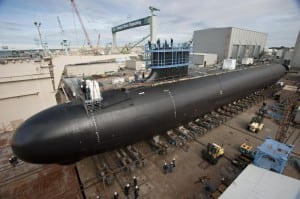The number two civilian at the Department of the Navy on Wednesday said the government needs to balance the constraints and stress the defense industrial base is under with accountability as the Navy seeks to grow and work with Australia on new submarines.
“We have to keep our eyes wide open to the constraints that the industrial base is under. And there’s part of this where we need industry to perform to what they’ve promised and we need to hold them accountable. But also we need to work with industry to understand the stressors that are on their plate,” Under Secretary of the Navy Erik Raven said during the Defense News Conference on Sept. 7.

Raven noted the entire defense industrial base is experiencing issues with workforce and the ability to manage supply chains amid larger economic disruptions to both. He said while the Navy wants to work with industry to help fix these problems, they need feedback and assurances from industry as well.
“At the Navy, we’re prepared to be partners with industry to help solve some of those problems, but we also have to have accountability, and understand where we help them out, that we understand how quickly we can expect to see improvements.”
Raven said the government is specifically having this dialogue with industry across the board in shipbuilding.
“So labor has been a constraining factor in performance of the defense industrial base. And we are really interested in working with our industrial partners to just start to address that,” he added.
Raven confirmed the Navy is starting to see impacts from high inflation levels, particularly in ships.
“If you look at even the [fiscal year 2023] budget, there’s numbers in there for cost to complete. That basically means where Congress has given us a certain amount of money to buy ships and for a variety of reasons, whether it’s supply chain, whether it’s just the vicissitudes of the world, the cost has increased. And so we’re starting to see some cost to complete impacts creeping into not only ‘23 but future year’s budget, and we’re going to deal with those.”
Raven said this emphasizes the need for DoD to work with industry on two tracks, “making sure that where we can cooperate with industry and go hand in hand into important things like expanding the labor force, we want to be there. But also there’s work for industry to be done.”
He said while industry assumes responsibility to manage its supply chain well to perform on cost and on schedule as best as possible, “we also need to hold industry accountable for delivering what it’s promised.”
When asked how the Navy can balance accountability and supporting vendors without pushing them out of the defense sector, Raven said the first way is to not look at stovepipes, but look across portfolios.
“It’s very easy to slice up the defense budget into how many of this type of airplane are we buying, how many of this ship are we buying, and to really dive down deep into each one of those issues,” he continued.
Raven underscored the shipbuilding companies each work on multiple programs and “we need to understand how they see their challenges, not just in one particular program, but all the business areas that they are in.”
In turn, that will allow the Navy to “get that full picture of what labor is required, what does the supply chain look like, is it different for each one of these programs?”
Raven argued this means the Navy must start engaging with industry on the basis of “looking across the horizon” to help solve multiple problems, and not focus on deep dives into each specific problem.

Separately, when asked how things like the 30-year shipbuilding plan helps inform the American industrial base to prepare for major programs like the U.S.-U.K.-Australian AUKUS submarine partnership, Raven said after the [five year Future Years Development Program] you can “then start looking at future years and how that can diverge in various ways based on different scenarios, and also changing demand signals, the world does not stay static.”
He said the Navy expects the Defense Department and industrial partners “to be able to work and change approaches to circumstances as the world changes. So I think that shipbuilding plan really hits the mark in those, in providing that short term, five-year look at what we really expect to be able to support in this and future budgets. And then provide that longer term look of these are the directions we’re going and allow the time for industry to be able to react and optimize to that.”
The three AUKUS countries are currently in the middle of an 18-month consultation to help Australia figure out how to procure nuclear-powered attack submarines.
When asked for updates on the AUKUS discussion, Raven said that “some time in the future, journalists and historians are going to look back at this moment and look at how much work has been done over the past 12 months of this consultation period and ask: ‘Why can’t DoD react as quickly to a major program and establish requirements and a process to meeting those strategic goals as quickly as we have been doing?'”
Raven noted that “we don’t have solutions ready for prime time, but what we have been doing over the past 12 months is really spending that engaging with our partners, understanding what capabilities we all have to bring to the table, what capabilities are needed, and start aligning those against how are we going to perform to plan,”
In July, Deputy Prime Minister and Defense Minister of Australia Richard Marles told reporters the Australian government plans to announce its choice for a submarine in the first quarter of 2023 (Defense Daily, July 15, 2022).
Raven said while the government does not yet have any announcements for the ultimate submarine decision or steps to it, the government is looking at what capabilities exist in the U.S. and with its two partners, and how to grow these capabilities “over the next several years and what are the intermediate steps needed to get there.”
“It’s a very complex program, but we’re making great progress,” he added.